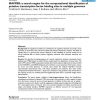Free Online Productivity Tools
i2Speak
i2Symbol
i2OCR
iTex2Img
iWeb2Print
iWeb2Shot
i2Type
iPdf2Split
iPdf2Merge
i2Bopomofo
i2Arabic
i2Style
i2Image
i2PDF
iLatex2Rtf
Sci2ools
BMCBI
2005
2005
MAPPER: a search engine for the computational identification of putative transcription factor binding sites in multiple genomes
Background: Cis-regulatory modules are combinations of regulatory elements occurring in close proximity to each other that control the spatial and temporal expression of genes. The ability to identify them in a genome-wide manner depends on the availability of accurate models and of search methods able to detect putative regulatory elements with enhanced sensitivity and specificity. Results: We describe the implementation of a search method for putative transcription factor binding sites (TFBSs) based on hidden Markov models built from alignments of known sites. We built 1,079 models of TFBSs using experimentally determined sequence alignments of sites provided by the TRANSFAC and JASPAR databases and used them to scan sequences of the human, mouse, fly, worm and yeast genomes. In several cases tested the method identified correctly experimentally characterized sites, with better specificity and sensitivity than other similar computational methods. Moreover, a large-scale comparison u...
| Added | 15 Dec 2010 |
| Updated | 15 Dec 2010 |
| Type | Journal |
| Year | 2005 |
| Where | BMCBI |
| Authors | Voichita D. Marinescu, Isaac S. Kohane, Alberto Riva |
Comments (0)

